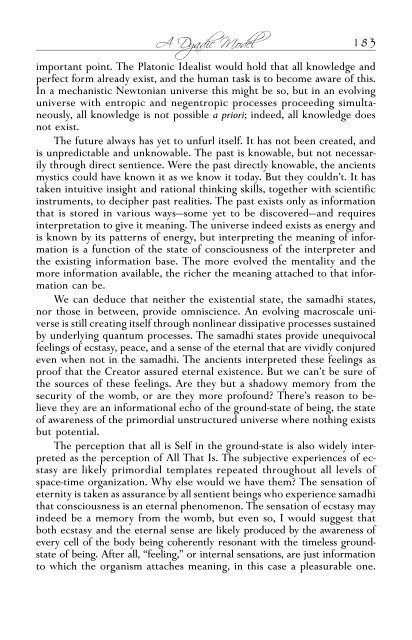edgar-mitchell
edgar-mitchell
edgar-mitchell
Create successful ePaper yourself
Turn your PDF publications into a flip-book with our unique Google optimized e-Paper software.
92<br />
The Way of the Explorer<br />
eagerly agreed, and through the course of the engagement we knew we<br />
had achieved both a public relations and financial success, though the gettogether<br />
was criticized for having too much speech-making and not enough<br />
entertainment. But as a result of the evening we raised nearly $20,000.<br />
Once again, it looked as though our doors could remain open for a while<br />
longer.<br />
Money is a curious thing. There is always the temptation to turn an<br />
organization into something that was never intended just to keep it alive.<br />
This is a corrosive phenomenon common to all underfunded ventures, and<br />
I was always afraid the institution would lose its idealism were we to indulge<br />
too enthusiastically in fundraising for the sake of fundraising. The<br />
Institute of Noetic Science was founded so that serious scientific work and<br />
discourse could be conducted concerning this elusive phenomenon we<br />
call consciousness, not merely to perpetuate itself. So we had to address<br />
this dilemma day in and day out if we were going to remain legitimate. We<br />
were successful, but in the beginning we paid dearly for our idealism.<br />
The research we sponsored in these early years I am proud of to this<br />
very day. It was all cutting-edge, much of it considered “far out” at the<br />
time. But all of it would lay a solid groundwork for the future. Dr. Carl<br />
Simonton, an oncologist who was just finishing his military service, was<br />
interested in how individual attitudes and thought processes influence those<br />
afflicted with illness, particularly cancer. With the help of influential board<br />
members, we raised the funds to assist Simonton in his research. Brendan<br />
O’Regan, a biochemist working at Stanford Research Institute at the time,<br />
urged us to focus on health issues in general. He directed noetics efforts in<br />
the medical areas, and initiated the first research in several areas relating<br />
to health topics, such as the effectiveness of meditation and acupuncture.<br />
Today it is widely considered the earliest and best work of its kind. We<br />
were also enthusiastic about the biofeedback work of Drs. Elmer and Alyce<br />
Green. O’Regan became the institute’s vice president of research in 1975,<br />
and worked in that capacity with unflagging dedication until his untimely<br />
death in 1992. 1<br />
As the decade rolled on, the relentless challenge of running the institute<br />
gradually took its toll. In 1974 Anita and I had married, and her children<br />
from a previous marriage were nearing college age. Karlyn was just<br />
graduating, and Elizabeth was still an undergraduate. As every parent<br />
knows, this takes money. In 1978 and 1979 I had to concentrate on meeting<br />
this need, so I tried to recruit particular individuals who could keep<br />
the dream alive, as it were, but with the intention of returning full-time as<br />
soon as possible. Along with Brendan O’Regan, I had met Dr. Willis Harman,<br />
who at the time also was working at the Stanford Research Institute. After<br />
a campaign of persuasion by the institute’s directors, he finally came on<br />
board as president. Diane Brown (Temple) managed the administrative


